If you’re planning your first trip to Madrid, in this post we’re giving you everything you need to know before your trip. From when to visit, where to eat, how to get around, where to stay, budget hacks, tips on local customs, and even a secret day trip at the end you might not have thought of!

Everything You Need to Know Before Your Trip to Madrid
- Best places to eat in Madrid
- Local customs you need to know
- How to Get Around Madrid: Simple Tips for Public Transport
- How to get from the airport to the city centre
- Where you should stay (best accommodation hack)
- When is the best time to visit Madrid?
- How to see the main sites in just a few hours
- Apps you need when traveling in Madrid
- Secret day trip destination you never thought of!
Best Places to Eat in Madrid
Madrid is full of incredible restaurants and cafés. In our How to Spend 24 Hours in Madrid post, we shared our top picks for breakfast, lunch, and dinner. But since then, we’ve discovered a few new spots we just had to add.
Here they are:
Balbisiana
This place was started by a former lawyer turned baker. And wow, she nailed it! The branding is soft, elegant, and just so beautiful. Every time we go, we fall in love with the vibe all over again.
The coffee is excellent, and the pistachio and white chocolate tart is a must. They also offer picnic and brunch boxes you can pre-order. Order one online, pick it up and head to Retiro Park, it’s the perfect combo.
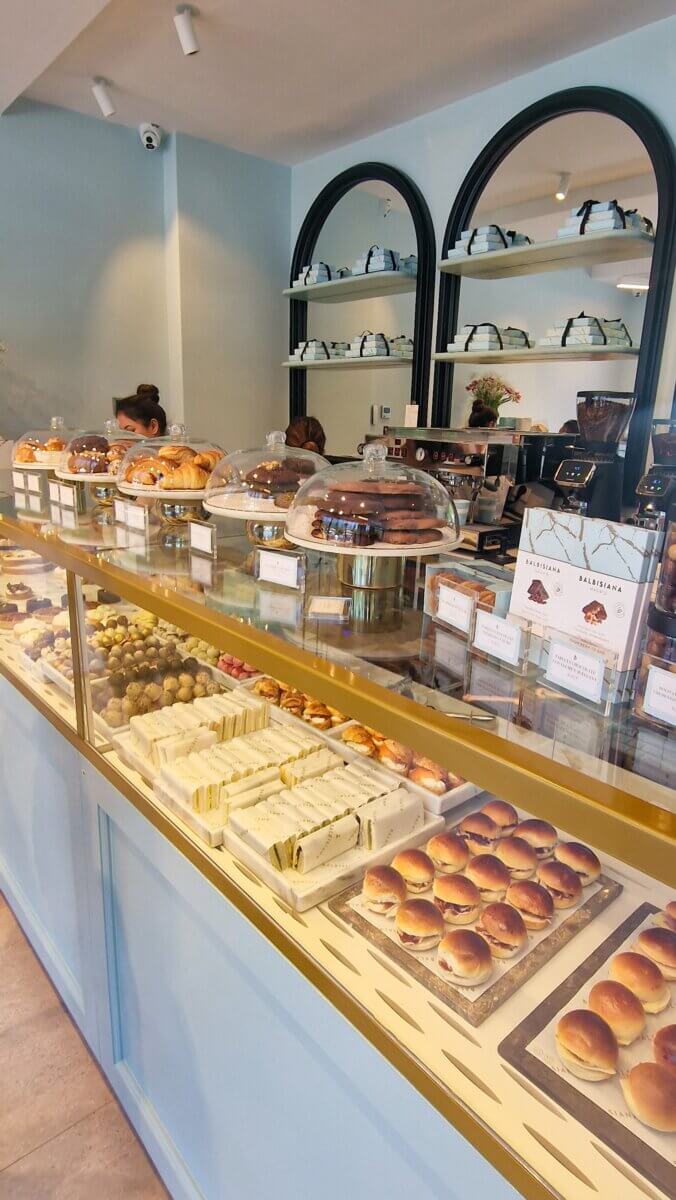
Castizo
If you’re craving traditional Spanish food in a stunning setting, go here. The decor is classy, the prices are fair, and the food is amazing. There are a few locations around the city, but we love the one in Serrano.
Our top picks: morcilla (blood sausage), pimientos de padrón (little grilled green peppers topped with olive oil and flakey salt), and the crispy pig’s ear. Yes, pig’s ear! It’s surprisingly delicious.
La Bistroteca
We found this one very recently and were seriously impressed. The staff were warm, welcoming, and super professional.
And the food? Incredible. The nachos and burgers are some of the best we’ve had in Madrid (maybe ever!). And we’ve tried a lot of nachos and a lot of burgers.
Just a tip—book in advance. It gets busy, and there are two locations really close to each other, so double-check the address before you go.
Local customs you need to know
- Madrileños eat late. Like, really late compared to what most of us are used to. Lunch kicks off around 2 p.m., and dinner? You’re looking at 9:30 or 10 p.m. That’s when the vibe really comes alive. If you want to have dinner between 6-8 p.m., then keep in mind you might be the only ones in the restaurant.
- Tipping isn’t mandatory. A small tip is appreciated but not expected. Like most countries in Europe, service charges are included in the workers’ salary. Round up the bill or leave €1–€5 if the service was exceptionally good.
- The pace is slower here, even though it’s a city. People in Spain like to take their time, it’s totally normal to sit back, relax, and really enjoy your meal. This is called sobremesa. Sobremesa in Spain is the time after a meal when everyone stays at the table, talking and relaxing. No one rushes off, it’s all about enjoying the moment together, usually over a coffee.
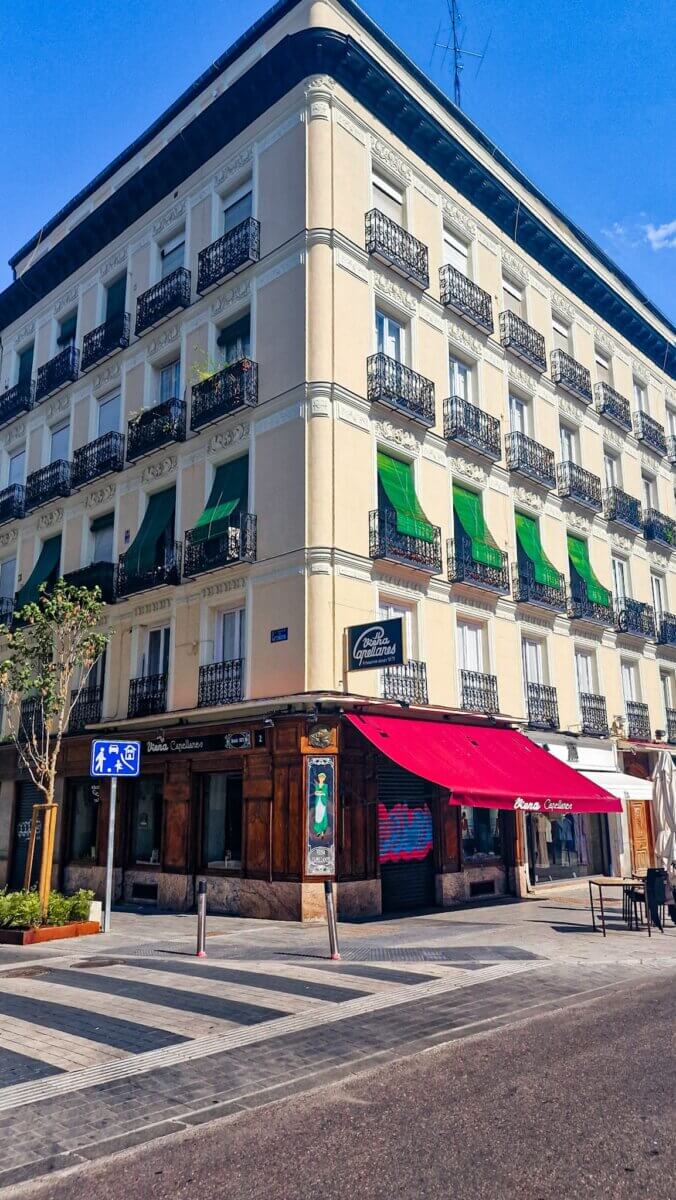
How to Get Around Madrid: Simple Tips for Public Transport
Madrid has a super reliable public transport system. Whether you’re on a budget or want convenience, there’s something for everyone. You’ve got the Metro, local trains, buses, taxis, scooters, bikes, and rideshare apps like Uber, Bolt, and Cabify. All are easy to use, but some are definitely better than others.
Metro and Buses
To ride the Metro or EMT/ALSA buses, you’ll need a transport card. The most common one is the Tarjeta Multi. You can buy and top it up at any Metro station or tobacco shop.
But honestly, the easiest way? Use the Tarjeta Transporte app (we’ve linked it in the video description). Just sign up and add your card details before your trip to avoid stress.
If you’ll be riding often, a transport pass saves time and money. If not, single tickets are fine (usually around 1,50€), especially if you plan to walk a lot.
Buses: EMT and ALSA
There are two main bus services in Madrid. EMT buses run within the city and ALSA covers intercity routes.
We break down both services in our Madrid transport post—costs, routes, and how to use them.
Free transport tip
Want to save even more? Hop on Bus 001, it’s completely free! It runs from Atocha to Gran Vía and Paseo del Prado. This means easy access to spots like the Prado Museum and other tourist favorites. It runs from 7 AM to 11 PM and comes every 7–8 minutes on weekdays.
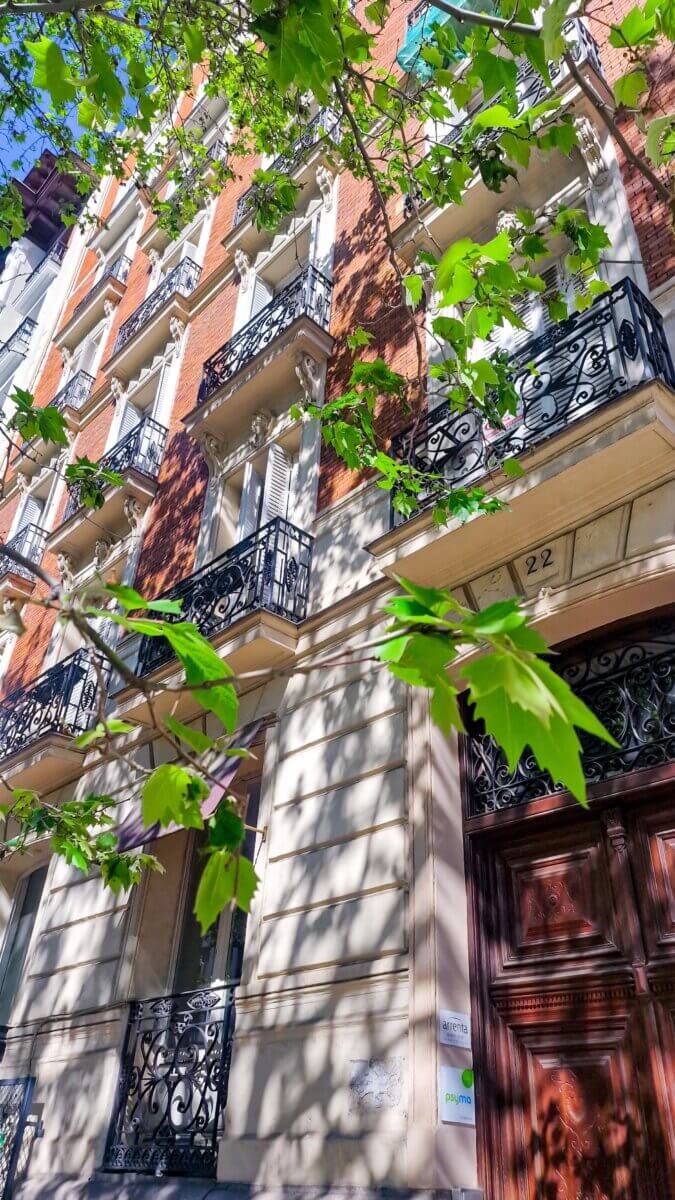
Trains: Renfe Cercanías
Madrid’s commuter trains are called Cercanías. They’re run by Renfe and are great for longer distances.
They connect the city with nearby towns like Aranjuez, El Escorial, and Cercedilla. Perfect for day trips or places the Metro doesn’t reach.
Main stations: Atocha and Chamartín-Clara Campoamor.
You’ll need a separate ticket for these, not compatible with the Tarjeta Transporte app. You can buy them at the station machines.
What to Skip
We recommend skipping taxis, car rentals, and rideshares. They can get expensive fast and honestly aren’t worth it most of the time. Madrid is super walkable, and the public transport system works like a charm.
Need Help Navigating It All?
Check out our full video for a step-by-step guide. We’ll show you how to buy tickets, use the machines, read the Metro map, and more. Plus, we’ll tell you which lines take you to the big attractions—and which ones to avoid.
Getting around Madrid doesn’t have to be stressful. With the right tools, it’s easy, cheap, and actually kind of fun.
Sing up for our weekly newsletter and get a FREE Packing List Template!
How to get from the airport to the city centre
The easiest and most budget-friendly option is taking Line 8 on the metro. There are two stops at the airport, depending on which terminal you arrive at. The stop here (Barajas) is actually just a neighborhood by the airport. From there, Line 8 will take you to Nuevos Ministerios, which connects to three other lines.
Depending on where you’re staying, you can either get off at the first connecting stop, Mar de Cristal on the brown line, or the second one, Colombia on the dark purple line.
Another easy and budget-friendly option is the bus.
The simplest choice is to hop on a direct bus from the terminal where your flight lands straight into the city center—like the 203 line or the Airport Express Bus. This one runs 24/7 and connects the airport to key spots in central Madrid, such as O’Donnell, Cibeles, and Atocha. Just a heads-up: if you’re arriving late at night (between 11:30 p.m. and 6 a.m.), the bus skips the Atocha stop.
A ticket to the city center costs 5€. If you have a lot of luggage, the metro might be a nightmare because of the stairs and connections.
In that case, you might want to consider taking a taxi or Uber. Taxis have a flat rate of 33€ (which you can pay by card in all taxis), but Bolt (a budget-friendly version of Uber) sometimes offers discounts, so it’s worth checking both options first.
The last option is the Cercanías Renfe trains, but keep in mind they only leave from Terminal 4.
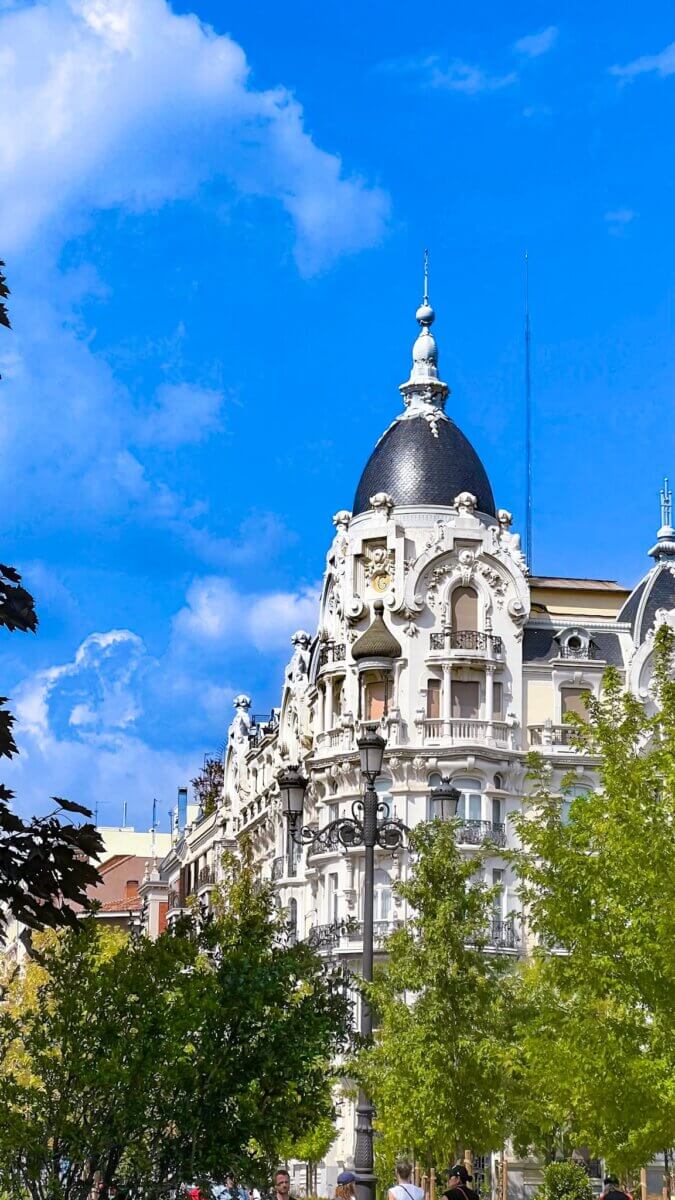
Where to stay in Madrid: Why Staying Near a Metro Line in Madrid Is Totally Worth It
Here’s a tip a lot of people overlook: stay near a Metro line. It makes getting around so much easier.
Many budget travelers think staying outside the city will save money. But it’s not always true. Sure, accommodation might be cheaper farther out. But you’ll probably spend more on transport just getting into the city. Plus, the commute eats up time you could spend exploring.
Staying on the Metro line keeps things simple, fast, and convenient. You’ll thank yourself later.
Want more smart travel tips? Check out our post on booking flights and accommodation on a budget—we’ve linked it right here!
When is the best time to visit Madrid?
Let’s start with the short answer: the best time to visit Madrid is Spring or Autumn. Winter comes second. And Summer—well, it’s not our favorite.
Here’s why:
Spring ( late March to May)
Spring in Madrid is hard to beat. The weather is sunny and mild, with some chances of rain. The parks bloom with pink and white almond blossoms—truly a sight.
You’ll catch San Isidro, Madrid’s traditional festival full of parades, food, and dancing. It runs from May 3rd to the 15th, and locals really go all out.
This is also terrace season—order a tinto de verano and enjoy the sun.
But just a heads up: crowds are common, so plan ahead.

Autumn (late September to November)
Autumn is another great choice. Temperatures are cooler but still comfortable for walking and sightseeing. The city turns orange and brown, perfect for photo lovers.
Stop by San Ginés for warm churros and chocolate.
Or check out the Madrid Jazz Festival if you’re into music.
It’s cozy, festive, and still full of life.
Winter (December to February)
Winter isn’t a bad option either. Madrid goes all out for Christmas. Expect glowing lights, markets, and lots of festive cheer.
Flights and hotels cost more in December, but it’s worth it for the vibe.
Just pack layers—Madrid gets cold.
Snow is rare in the city, but you can find it in the nearby mountains. They’re easy to reach by car or public transport.
Summer (June to August)
We don’t usually recommend visiting in Summer. It’s hot—often over 40°C. The heat lingers even at night, making it hard to sleep.
That said, Madrid is quiet during this time. Most locals leave the city for the coast or their pueblo (their family’s hometown). So if you hate crowds, this could work in your favor.
However, it’s festival season, great for live music and outdoor events. So, if this is something that interests you, this could actually be the best time to come.
Now, about prices.
The cheapest time to visit Madrid is mid-November to mid-March—except for holidays like Christmas and New Year’s. January and February are the absolute cheapest months. On the flip side, prices jump from late Spring through early Summer. They rise again in September and early October.

How to see the main sites in just a few hours
We recommend starting your day in Retiro Park. It’s peaceful, green, and a great way to ease into the city. From there, take a 20-minute walk to Sol. Or, if you’re feeling adventurous, grab a public bike—there are lots of stations near the park.
On the way, you’ll pass some must-see spots:
- Puerta de Alcalá
- Cibeles Palace
- The Metropolis Building
- The Four Seasons Hotel
- Plaza de Canalejas
Don’t go through Gran Vía just yet—we’ll save that for later! Once you reach Puerta del Sol, walk two minutes to Plaza Mayor. From there, it’s just another two to Mercado de San Miguel. This market is popular with tourists, so it can be pricey. But if it’s in your budget, grab a glass of wine and a tapa—it’s worth it for the experience.
Next, take a 10-minute walk to Plaza de Oriente. You’ll find beautiful gardens and the Felipe IV monument. Right next to it is the stunning Royal Palace and the Almudena Cathedral. We love this cathedral, it’s gorgeous inside and out. Be sure to head to the Mirador de la Cornisa. You’ll get amazing views of the palace gardens and the city skyline.
From there, walk 5 minutes to Plaza de España. This square is lovely and also where you’ll spot the tall, iconic Riu Hotel. And yes, you can go up! It’s €10, and the views are incredible. There’s even a glass floor you can walk over—if you’re brave enough.
Now that you’re near Gran Vía, this is your chance to explore it. Gran Vía is known for shopping, nightlife, and especially theatre. Why not end your day with a show?
Want Our Full List of Must-Sees in Madrid?
We’ve put together a free download with everything you need: Top sights, hidden gems, our favorite restaurants and cafés, foods to try, and more. Go grab yours!
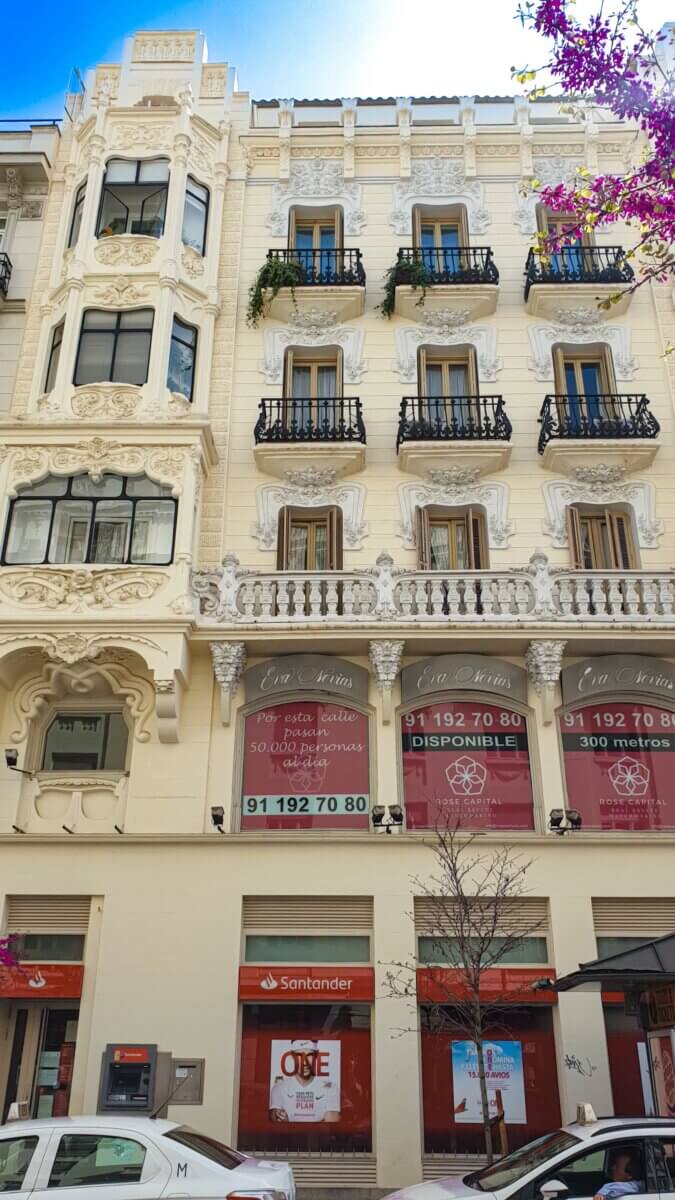
Apps you need when traveling in Madrid
BiciMad
Download the official app called BiciMAD. It’s available for both iOS and Android. The app lets you locate bikes or scooters, unlock them, and track your rides.
You need to sign up in the app. Both residents and visitors can use the service. You’ll need a payment method to register.
There’s no specific time limit, but you’re charged based on how long you use the bike or scooter.
BiciMAD has numerous stations across the city where you can pick up or drop off bikes. Keep in mind that bikes must be returned to a BiciMAD station, while scooters need to be parked in designated zones.
Revolut
Revolut is a digital banking app that makes spending money while traveling in Europe super easy. One of its biggest perks is no hidden currency conversion fees. You can pay in local currencies at the real exchange rate, avoiding the extra charges that banks and credit cards usually add.
You can also withdraw cash from ATMs, and even track your spending in different currencies, all from your phone. It’s a great way to save money and avoid surprises while traveling!
If you prefer not to pay with your phone, you can order a physical debit or credit card that arrives in a few business days.

GetYourGuide
GetYourGuide is a travel booking platform that helps you find and book tours, activities, and experiences in cities all over the world, including Europe.
You can make last-minute bookings easily and if your Plans change it’s not a problem because many (if not most) activities offer free cancellation up to 24 hours before.
Download GetYourGuide here.
Tricount
Tricount is a group expense-tracking app that makes it easy to split costs when traveling with friends or family in Europe. Instead of keeping messy receipts, you simply enter expenses, and the app calculates who owes what—no more awkward money talks!
It works offline, supports multiple currencies, and even lets you add expenses in different amounts (like if one person paid more for a meal).
As someone who is terrible at math, I really benefit from an app like Tricount because I don’t have to calculate how much I owe each person.
Tricount works in a way that even if I owe 3 different people, I only pay one person and it works out the difference so each person gets paid fairly in the least amount of transactions possible.
Sevilla: a day trip from Madrid you’ve never even considered
If you’re in Spain, you can’t skip Seville — it’s about as quintessential Spain as it gets.
In this YouTube ‘short’, we’re showing you how we did a day trip from Madrid: what we saw, what we spent, and how we got there. If you don’t have a car, we recommend booking train tickets on Omio — it compares prices across different companies so you can find the best deal.
And once you’re in Seville, don’t miss Plaza de España, it’s seriously stunning. I knew it would be beautiful by looking at pictures, but when I actually saw it, I was blown away! No picture or video does it justice. Just avoid going in summer… it’s even hotter than Madrid!

Leave a Reply